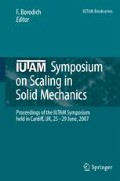Abstract
A detailed analysis of damage accumulation in metal specimens under irradiation, tension, mechanical and thermal fatigue shows that it occurs in two stages, the first being dominated by defect accumulation and the second, by defect growth. The stages are characterized by different sensitivity of defects to material structure and different defect size distributions. During the first stable stage, when most defects do not exceed the grain size, the defects initiate, grow and are blunted on reaching the maximum density determined by loading conditions and material structure. The cumulative number – size distributions of defects at this stage are described by exponential laws. The next stage is that of accumulation of defects of the next hierarchical level and transition to this stage occurs by coalescence of defects of the preceding level. The patterns of defects are self-similar. Formation of propagating microcracks whose length is significantly larger than the grain size leads to initiation of the accelerated stage of damage development which is described by a power–like cumulative size – frequency distribution of defects. The slope of this distribution decreases with load and fractal dimension of the damage patterns which form under tension and cyclic loading. The study of evolution of localized plastic zones at different loading stages shows that the size of the plastic zone may be considered to be the correlation length of the damage accumulation process. Analysis of damage process in terms of phase transition theory allowed us to suppose that the above-mentioned stages can be related to the self-organized criticality of accumulation of non-propagating defects and to the criticality due to a macrocrack formation.
Access this chapter
Tax calculation will be finalised at checkout
Purchases are for personal use only
Preview
Unable to display preview. Download preview PDF.
References
Botvina L.R., Barenblatt G.I. “Self – similarity of damage accumulation”, Problems of Strength, no.12, pp. 17–24, 1985.
Barenblatt G.I., Botvina L.R. “Self – similarity of fatigue fracture: Damage accumulation”, Izvestia AN SSSR., Mechanics of Materials,no. 2, pp. 88–92, 1983.
Botvina L.R., Zharkova N.A. “Self – similarity of the radiation defects accumulation process”, Scripta metallurgica, vol. 38, no 12, pp. 1829–1833, 1998.
Paskan N.H. “Fluence and dependence of void formation in pure aluminum”, Journal of Nuclear Materials, vol. 40. no. 11, pp. 11–17, 1971.
Bethge K., Munz D., Neumann J. “Crack initiation and crack propagation under thermal cyclic loading”, High Temperature Technology, vol.8, no. 2, pp. 98–104, 1990.
Botvina L.R., Mochov V.N. “On parameters determining a character of dynamic fragmentation of steel shells”, Deformation and fracture of materials,no. 12, pp. 19–25, 2006.
Kolmogorov A.N. “On logarithmically normal law of distribution of particles by size at fragmentation”, Dokl. AN SSSR, vol. 31, no. 2, pp. 99–101, 1941.
Rundle J.B., Klein W., Turcotte D.L., Malamud B.D. “Precursory seismic activation and critical – point phenomena”, Pure and Applied Geophysics,vol. 157, pp. 2165–2182, 2000.
Tyutin M.R., Botvina L.R., Zharkova N.A., Petersen T.B., Hudson J.A. “Evolution of damage in low – carbon steel in tension condition”, Strength, Fracture and Complexity,no 3, pp. 73–80, 2005.
Botvina L.R., Tyutin M.R. “Fractal properties of multiple fracture patterns”, Reports of Russian Academy of Science, vol. 417, no 3, pp. 385–388, 2007.
Botvina L.R., Petersen T.B., Zharkova N.A., Tyutin M.R., Budueva V.G. Acoustic properties of low carbon steel at various stages of fracture process”, Deformation and fracture of materials,no. 4, pp. 35–41, 2005.
Cladouhos T.T., Marrett R. “Are fault growth and linkage models consistent with power – law distributions of fault length?” Journal of Structural Geology,vol. 18, no. 20, pp. 281–293, 1996.
Turcotte D.L. “A fractal model for crustal deformation”, Tectonophysics,vol. 132, pp. 261–269, 1986.
Botvina L.R. “Kinetic similarity of fracture processes on various scale levels”, Intern. Journal of Fracture,vol. 128, pp. 133–137, 2004.
Hatton C.G., Main I.G., Meredith P.G. “A comparison of seismic and structural measurements of scaling exponents during tensile subcritical crack growth”, Journal of Structural Geology,vol. 15, no. 12, pp. 1485–1495, 1993.
Ponomarev A.V., Zavyalov A.D., Smirnov V.B., Lockner D.A. “Physical modeling of the formation and evolution of seismically active fault zones”, Tectonophysics, vol. 277, pp. 57–81, 1997.
Hirata T. “A correlation between the b – value and the fractal dimension of earthquakes”, Journal Of Geophysical. Research, vol. 94, pp. 7507–7514, 1989.
Onsel A.O., Main I., Alptekin O., Cowie P. “Spatial variations of the fractal properties of seismicity in the Anatolian fault zones”, Tectonophysics,vol. 257, pp. 189–202, 1996.
Keilis-Borok V.I., Malinovskaya L.N. “One regularity in the occurrence of strong earthquakes”, Journal of Geophysical Research,vol. 69, no. 14, pp. 3019–3025, 1964.
Bowman D.D., Ouillon G., Sammis C.G. et al. “An observational test of the critical earthquake concept”, Journal of Geophysical Research,vol. 103, no. B10, pp. 24359–24372, 1998.
Botvina L.R., Shebalin P.N., Oparina I.B. A mechanism of temporal variation of seismicity and acoustic emission prior to macrofracture, Doklady Physics(Translated from Doklady Akademii Nauk of Russia), vol. 46, pp. 119–123, 2001.
Author information
Authors and Affiliations
Editor information
Editors and Affiliations
Rights and permissions
Copyright information
© 2009 Springer Science+Business Media B.V.
About this paper
Cite this paper
Botvina, L. (2009). Scaling in Damage Accumulation. In: Borodich, F. (eds) IUTAM Symposium on Scaling in Solid Mechanics. Iutam Bookseries, vol 10. Springer, Dordrecht. https://doi.org/10.1007/978-1-4020-9033-2_17
Download citation
DOI: https://doi.org/10.1007/978-1-4020-9033-2_17
Publisher Name: Springer, Dordrecht
Print ISBN: 978-1-4020-9032-5
Online ISBN: 978-1-4020-9033-2
eBook Packages: EngineeringEngineering (R0)

